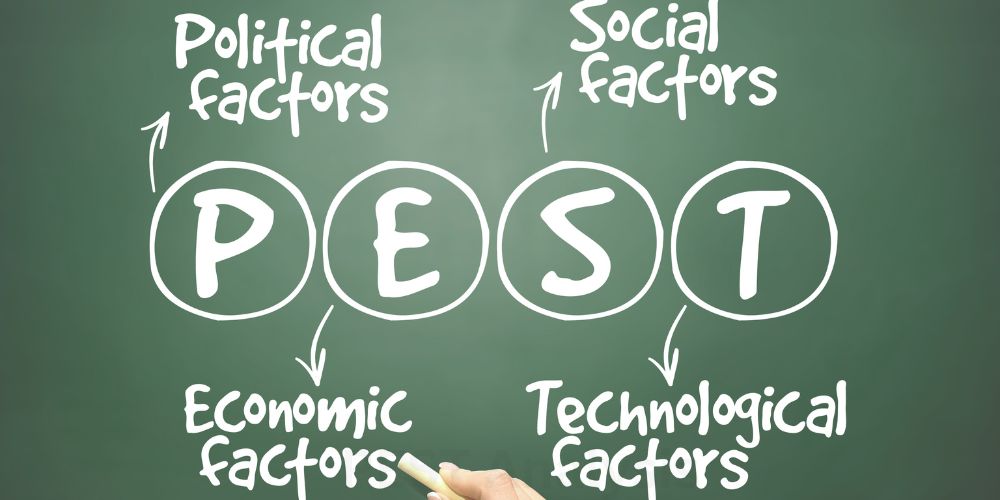
In today’s unpredictable business environment, organizations can’t afford to rely on internal strengths alone. External factors—political shifts, changing consumer behavior, economic fluctuations, and emerging technologies—shape every strategic decision. That’s where PEST Analysis becomes a powerful tool.
What is PEST Analysis?
PEST Analysis is a strategic management tool used to evaluate the macro-environmental factors that impact a business. The acronym stands for:
-
P – Political
-
E – Economic
-
S – Social
-
T – Technological
Sometimes extended to PESTLE (adding Legal and Environmental), this analysis helps organizations anticipate external influences and align strategies accordingly.
Fact Check: According to a report by Harvard Business Review, over 70% of Fortune 500 companies incorporate PEST or PESTLE analysis as part of their strategic planning framework.
Components of PEST Analysis
1. Political Factors
These include government policies, taxation, trade tariffs, labor laws, and political stability. A stable political climate creates opportunities, while uncertainty increases risks.
Example: When the Indian government introduced the GST reform, many businesses had to re-structure supply chains and pricing models to stay compliant.
2. Economic Factors
Economic health determines consumer spending, cost of capital, inflation rates, and exchange rates. A recession may decrease demand, while economic growth often boosts sales.
Stat: The IMF projected global GDP growth of 3.2% in 2025, directly impacting investment and expansion strategies for multinational firms.
3. Social Factors
These focus on demographics, cultural trends, lifestyle changes, education levels, and consumer behavior. Social insights help businesses tailor products and services to customer needs.
Example: The rising demand for plant-based food reflects shifting consumer preferences toward health and sustainability, influencing global FMCG brands like Nestlé and Unilever.
4. Technological Factors
Innovation can disrupt entire industries. Businesses must monitor R&D, automation, digital transformation, and emerging tech trends.
Example: The adoption of AI-driven customer service has reduced costs and improved response times for companies like Amazon, raising industry benchmarks.
Real-World Example of PEST Analysis
Let’s analyze Tesla, Inc. through the PEST framework:
-
Political: Tax incentives for electric vehicles (EVs) in the U.S. and Europe boost sales, but trade wars and import tariffs can increase production costs.
-
Economic: EV demand is tied to oil prices and disposable income. Inflation or rising interest rates can make cars less affordable.
-
Social: Growing awareness of climate change fuels consumer interest in eco-friendly cars, increasing Tesla’s market appeal.
-
Technological: Advancements in battery technology and autonomous driving give Tesla a competitive edge, but competition in R&D is fierce.
Insight: Tesla’s success isn’t just about innovation—it’s about aligning business strategy with political incentives, social expectations, and technological revolutions.
Why is PEST Analysis Important?
-
Anticipates risks and opportunities in the external environment.
-
Guides long-term strategic planning and investment decisions.
-
Improves adaptability in rapidly changing markets.
-
Enhances competitive advantage by aligning business with trends.
Question for readers : When was the last time your organization revisited external factors that could reshape your strategy?
Limitations of PEST Analysis
-
Cannot predict sudden shocks (e.g., COVID-19 pandemic).
-
May oversimplify complex external environments.
-
Needs to be combined with other tools like SWOT and Porter’s Five Forces for deeper insights.
PEST vs. SWOT: What’s the Difference?
| Feature | PEST Analysis | SWOT Analysis |
|---|---|---|
| Focus | External factors | Internal + External |
| Scope | Macro environment | Organizational strengths & weaknesses |
| Usage | Market entry, expansion, long-term planning | Strategy development, competitive positioning |
FAQs on PEST Analysis
Q1. Who should use PEST analysis?
Any organization—startups, SMEs, large corporations, and even non-profits—can benefit from PEST analysis to align strategy with external influences.
Q2. How often should PEST analysis be updated?
Ideally, once or twice a year. However, during volatile market conditions, quarterly reviews are recommended.
Q3. Is PEST analysis qualitative or quantitative?
It is primarily qualitative, but can include quantitative data such as GDP growth rates, inflation percentages, or technological adoption metrics.
Q4. Can individuals use PEST analysis?
Yes! Professionals can apply PEST analysis for career planning by evaluating job markets, technology shifts, and economic conditions in their industry.
Final Thoughts
PEST analysis is not just a framework—it’s a lens through which businesses can future-proof themselves. By understanding political shifts, economic cycles, social trends, and technological changes, organizations can build resilient strategies and maintain competitive advantage.
In an era of uncertainty, the smartest businesses are those that adapt quickly to external forces—and PEST analysis provides the roadmap.
- The Role of Personality Development in MBA Career Success - October 5, 2025
- Best Online MBA Programs in USA - September 27, 2025
- How Important is AI for MBA Students? - September 18, 2025
